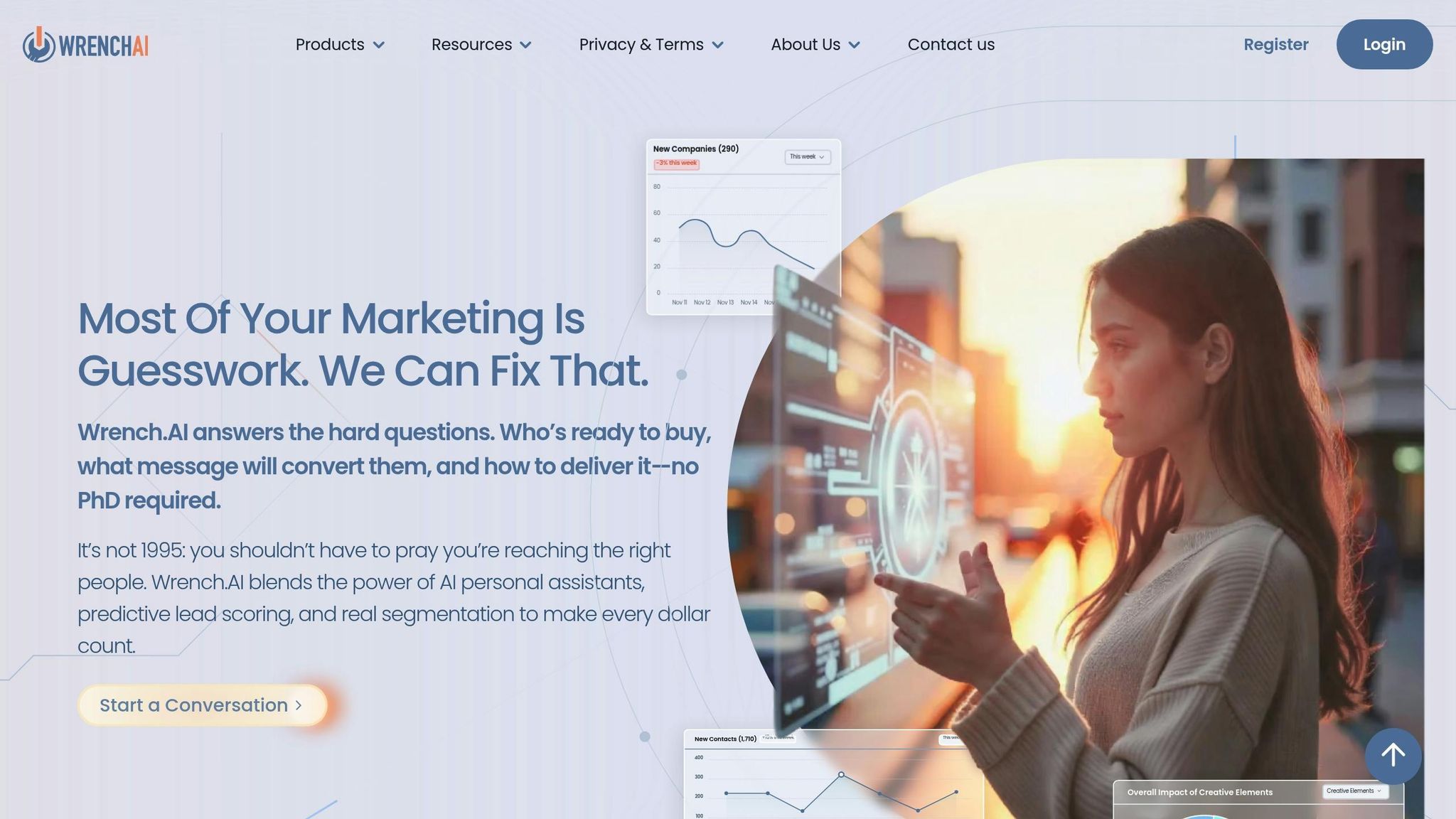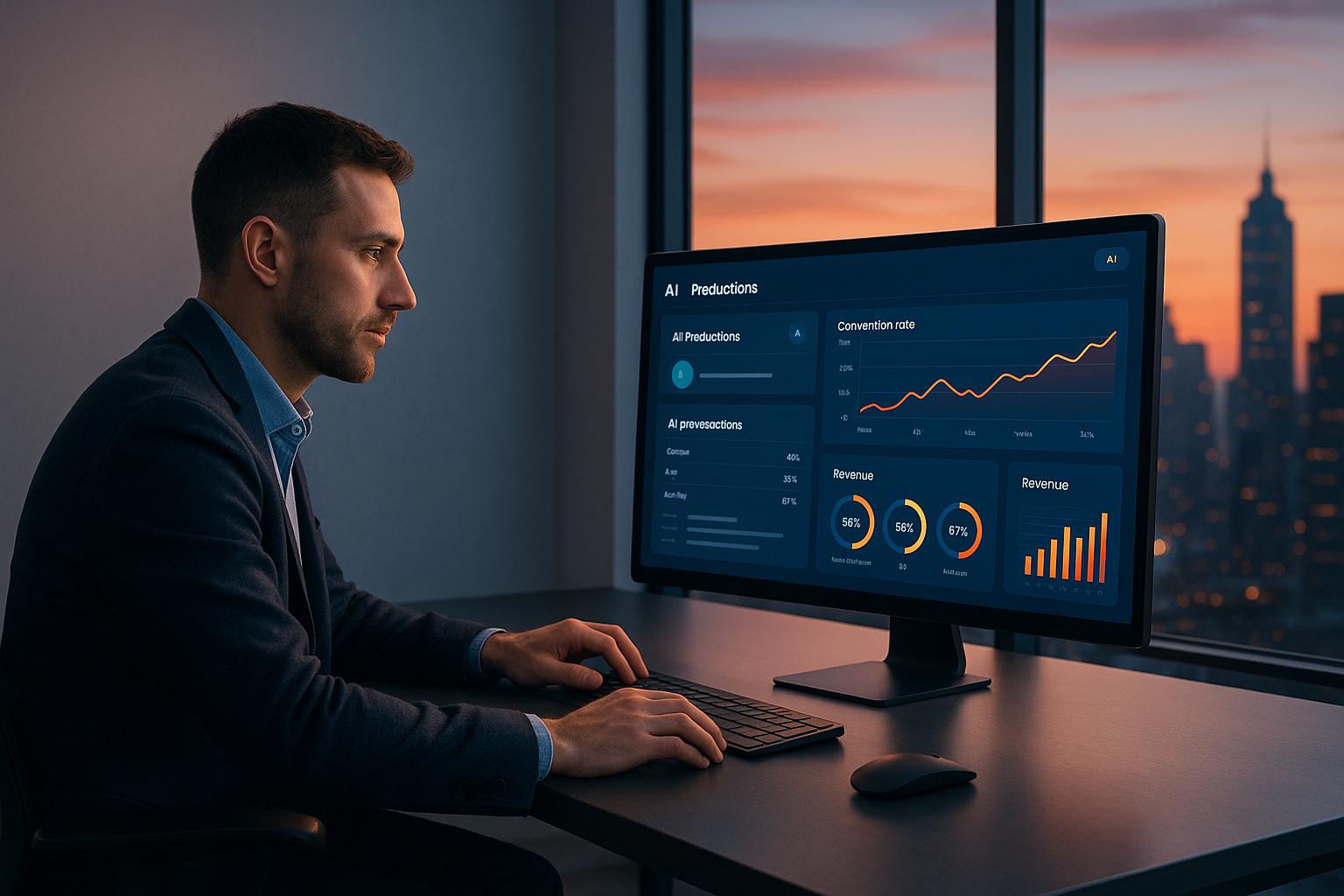AI-powered CTAs (Call-to-Actions) are transforming how businesses engage users by delivering personalized, data-driven messages that adjust in real time. Unlike static CTAs, these dynamic buttons use customer data – like browsing history, purchase behavior, and engagement patterns – to craft tailored prompts that resonate with individual users. Here’s a quick breakdown of how to create and optimize AI-powered CTAs:
- Step 1: Collect and Connect Data
Use tools like Google Analytics, CRM systems, and email platforms to gather customer data. Ensure data quality by cleaning, standardizing, and staying compliant with privacy laws. - Step 2: Segment Audiences with AI
AI analyzes patterns in customer behavior to create precise audience groups. Predictive analytics can forecast purchase intent, churn risk, and lifetime value for smarter targeting. - Step 3: Build and Test Dynamic CTAs
AI crafts CTAs tailored to users’ journey stages, using real-time triggers like exit intent or time spent on a page. It also optimizes design and messaging continuously. - Step 4: Track and Review Performance
Monitor metrics like click-through rates, conversion rates, and revenue per visitor. AI tools provide deeper insights and real-time adjustments to improve results. - Step 5: Automate and Scale with Tools
Platforms like Wrench.AI integrate with over 110 data sources, automate workflows, and optimize CTAs for ongoing performance – all while keeping costs low.
AI + Human Strategy = High-Converting CTAs
Step 1: Collect and Connect Your Data
To create effective AI-powered CTAs, you need high-quality data about your customers. Without it, even the smartest AI algorithms can’t deliver the personalized experiences that drive results. Let’s dive into where to find this data and how to keep it reliable.
Finding Key Data Sources
Customer data is scattered across various touchpoints. Identifying and leveraging these sources is essential for crafting personalized CTAs.
- Website analytics platforms like Google Analytics provide behavioral insights, including page views, time spent on site, bounce rates, and conversion paths. These metrics help AI understand user intent and engagement, shaping the timing and messaging of your CTAs.
- CRM systems store demographic details, purchase histories, and customer service interactions. This data helps AI decide whether to show a discount offer, recommend a premium product, or focus on retention strategies.
- Email marketing platforms track open rates, click-through rates, and engagement trends. These metrics reveal what resonates with different customer segments, guiding AI in crafting the most effective CTA language and offers.
- Social media platforms give insights into customer interests, brand interactions, and social behaviors. Though trickier to integrate, this data provides valuable context about customer preferences and lifestyle influences.
- Customer support systems hold records of pain points, satisfaction levels, and common questions. AI can use this information to create CTAs that address specific concerns or highlight relevant solutions.
The key to success is combining first-party data (data you collect directly) with behavioral data (how customers interact with your brand). This combination gives AI the context it needs to deliver meaningful, tailored experiences.
Maintaining Data Quality and Compliance
Low-quality data can derail your AI efforts. Errors like inconsistent formatting, duplicate entries, and outdated information lead to irrelevant or confusing CTAs, frustrating users and lowering conversion rates.
- Data standardization and validation ensure consistency across all sources. For example, customer names, addresses, and contact details should follow the same format, preventing AI systems from misidentifying the same person as multiple users.
- Regular data cleansing keeps your database current by removing outdated information and fixing errors. Since customer preferences evolve, stale data can result in irrelevant personalization. Automated processes can flag and update outdated records, ensuring your AI works with the latest information.
- Privacy compliance is critical, especially with regulations like GDPR and CCPA. Your data strategy must include consent management, data retention policies, and the ability to honor customer requests for data deletion or updates.
When AI relies on faulty data, it makes inaccurate assumptions about customer preferences, leading to poor results and frustrated users. Simplifying these tasks can be challenging, but solutions like Wrench.AI make it easier.
How Wrench.AI Streamlines Data Integration

Wrench.AI simplifies data integration by connecting with over 110 different data sources through one platform. This eliminates the need for custom integrations and ensures your AI-powered CTAs have access to complete customer data.
The platform’s data integration tools automatically clean and unify customer profiles by standardizing formats and removing duplicates. With accurate, consolidated data, AI can deliver highly relevant and impactful personalized CTAs.
For businesses with unique needs, custom API configurations enable integration with specialized systems or proprietary databases. This flexibility ensures companies with complex infrastructures can still benefit from AI-powered personalization without disrupting their existing setup.
Wrench.AI also uses selective data processing, so you only pay for the data you use. Pricing ranges from $0.03 to $0.06 per output, making it cost-effective to test different data combinations and uncover valuable insights for optimizing CTAs.
Finally, the platform handles data compliance automatically, managing consent and retention policies. This reduces the workload for marketing teams while ensuring your personalization efforts align with regulatory standards.
Step 2: Divide Audiences Using AI Data
After organizing your data in Step 1, the next task is to turn that information into actionable audience segments. Traditional segmentation methods often rely on basic factors like age or location. While useful, they don’t dive deep enough to predict how customers will respond to different calls-to-action (CTAs). AI-powered segmentation, on the other hand, analyzes deeper patterns – like behavior, intent, and engagement – to create precise groups that can guide more effective CTA strategies.
How AI-Based Segmentation Works
AI takes customer data and uncovers patterns that might otherwise go unnoticed. Unlike traditional methods that rely on fixed rules, AI identifies complex trends by analyzing multiple data points.
One method, behavioral clustering, groups customers based on how they interact with your brand across different platforms. For instance, AI might notice that customers who spend a lot of time on product pages, visit your site during specific times, and engage with your brand consistently are more likely to respond to urgency-based CTAs like "Limited Time Offer."
Another approach combines behavioral data with demographic and psychographic insights. This creates more detailed segments, such as tech-savvy millennials who research extensively before buying and prefer shopping on mobile devices. These refined segments allow you to craft CTAs that align closely with their motivations and habits.
Using Predictive Analytics for Better Targeting
Predictive analytics takes segmentation a step further by forecasting customer behavior, enabling personalized CTAs. For example:
- Purchase Intent Scoring: By analyzing browsing habits, email interactions, and seasonal trends, AI assigns a score predicting how likely a customer is to make a purchase. High-intent customers might see CTAs like "Complete Your Purchase" or "Get 10% Off Today", while lower-intent customers may receive educational CTAs like "Learn More."
- Churn Prediction: AI flags signs of disengagement, such as fewer email opens or longer gaps between visits. You can then target these customers with retention-focused CTAs, like special discounts or personalized offers.
- Lifetime Value Forecasting: This analysis helps prioritize customers based on their potential long-term value. High-value customers might receive CTAs for premium products or exclusive perks, while others might get introductory offers to build the relationship gradually.
- Optimal Timing Prediction: AI identifies the best times to deliver CTAs, ensuring messages reach customers when they’re most likely to engage.
Wrench.AI as a Segmentation Tool
Wrench.AI simplifies the process of turning predictive insights into actionable segments. Without requiring technical expertise, this platform processes behavioral, demographic, and engagement data to create clear audience groups that enhance CTA performance.
Its predictive analytics features automatically calculate intent scores and determine the best timing for each segment. This dynamic approach ensures your CTAs stay relevant, adjusting in real time as customers move through their journey – from first-time visitors to loyal repeat buyers.
For businesses with more complex customer relationships, Wrench.AI offers account-based insights to better understand high-value segments. Starting at just $0.03 to $0.06 per output, the platform’s pricing model makes it accessible to experiment with different segmentation strategies without a hefty investment.
Additionally, Wrench.AI automates workflows so that once segments are defined, the appropriate CTAs are sent automatically. As customers shift between segments, their CTA experiences update seamlessly. For businesses with specific needs, custom API configurations allow integration with proprietary systems or customer scoring models, ensuring even the most intricate customer bases benefit from AI-driven segmentation. This level of precision ensures your CTAs resonate with the right audience at the right time.
sbb-itb-d9b3561
Step 3: Build and Test AI-Powered CTAs
With your audience segments clearly defined in Step 2, it’s time to put personalization into action. This is where AI steps in to create CTAs (calls-to-action) that adjust in real time based on individual customer behaviors and preferences. What used to involve guesswork can now become a data-driven strategy. Let’s break down how to craft these dynamic CTAs and ensure they deliver results.
Creating Dynamic CTAs with AI
AI leverages natural language processing to analyze customer data and craft CTAs tailored to each visitor. It looks at things like browsing history, purchase habits, time spent on specific pages, and even seasonal trends to determine the ideal message and tone for each person.
For example, a first-time visitor might see a simple invitation like "Start Your Free Trial", while a returning customer who left items in their cart could get a more targeted message like "Complete Your Order – 15% Off Today." The AI evaluates where the customer is in their journey, how engaged they are, and what they’re likely to do next to choose the most effective call-to-action.
Beyond just the text, AI fine-tunes elements like urgency, value propositions, and even the action verbs used. Price-conscious shoppers might see CTAs emphasizing discounts, while premium-tier customers are presented with messages highlighting exclusivity or advanced features. AI also takes care of visual details, like the color and placement of the CTA, automatically optimizing these for the highest conversion rates – all without requiring manual input.
Using Contextual Triggers
Dynamic CTAs are just the beginning. Contextual triggers ensure that these messages appear at the most impactful moments, based on user behavior. AI monitors a range of signals to decide when and how to deploy CTAs for maximum effectiveness.
- Exit-intent triggers: These detect when a user is about to leave your site and display a last-ditch CTA. For instance, someone lingering on pricing pages might see a discount offer, while someone exploring product features could get an invitation to book a demo.
- Time-based triggers: These adjust based on how long someone spends on your site or a specific page. High-intent visitors might see a purchase CTA after just 30 seconds, while those in the research phase might receive educational content after a longer session.
- Scroll-depth and device triggers: These activate based on how far a user scrolls or the device they’re using. A technical buyer might see a detailed spec sheet after reviewing product details, while a decision-maker might get a consultation booking option after viewing case studies. Mobile users often receive simplified CTAs like "Call Now", while desktop users might see more detailed options.
Manual vs. AI-Generated CTAs: A Comparison
The difference between traditional manual CTA creation and AI-powered approaches becomes clear when you compare their strengths and limitations side by side:
| Aspect | Manual | AI-Powered |
|---|---|---|
| Personalization Scale | Limited to a handful of segments | Unlimited, tailored to individuals |
| Testing Speed | Weeks or months | Real-time, continuous improvement |
| Data Processing | Basic analytics | Deep analysis of hundreds of signals |
| Resource Requirements | High – requires multiple teams | Low – automated processes |
| Consistency | Varies with human input | Consistent, data-driven quality |
| Adaptation Speed | Slow, manual updates needed | Instant, adjusts to changing conditions |
Manual CTAs are great for smaller campaigns with fewer audience segments. They allow for creative control and ensure brand voice consistency. However, they’re less practical when dealing with diverse audiences or fast-changing environments.
AI-powered CTAs, on the other hand, shine when scale and precision are needed. They analyze customer behavior in ways humans simply can’t and adapt to trends far faster than manual methods. The system continuously learns from interactions, improving performance without requiring additional effort from your team.
For many established brands, a hybrid approach works best. AI can handle the heavy lifting – personalization, testing, and optimization – while human oversight ensures the CTAs stay aligned with the brand’s voice and creative goals. This blend allows you to benefit from AI’s efficiency while maintaining the strategic thinking that drives long-term success.
Platforms like Wrench.AI make this balance easier to achieve. They generate AI-powered CTAs while adhering to your brand guidelines and approval workflows. This ensures the personalization and scalability of AI without sacrificing the control and consistency that manual processes provide.
Testing becomes far more efficient with AI. Instead of running A/B tests over weeks or months, AI continuously evaluates hundreds of variations, promoting the top performers automatically. This means your CTAs improve daily, not monthly, leading to faster results and better overall performance.
Step 4: Track and Review Performance
After launching your AI-powered CTAs, the next critical step is tracking their performance. This goes beyond just monitoring numbers – it’s about understanding what’s driving results and using that knowledge to refine your CTAs. AI plays a key role here, making it easier and faster to uncover meaningful insights compared to traditional methods.
Key Metrics for CTA Success
Optimizing CTAs effectively means keeping an eye on several important metrics, not just click-through rates. These metrics provide a clearer picture of engagement and conversion.
- Click-through rate (CTR): This is a core engagement metric. AI allows you to dig deeper into CTR by analyzing factors like audience segments, time of day, and device type. This level of analysis can highlight increases in engagement compared to static CTAs.
- Conversion rate: This measures how well clicks translate into valuable actions. AI-powered CTAs often attract higher-quality traffic, leading to better conversion rates.
- Revenue per visitor (RPV): This tracks the dollar value each visitor generates. By tailoring messages with AI-driven personalization, you can boost your overall revenue impact.
- Time to conversion: This metric looks at how quickly users complete the desired action after clicking the CTA. AI helps speed up this process by delivering more relevant and timely messaging.
- Engagement depth: This measures how far users interact after clicking, such as time spent on your site or additional pages visited. AI-optimized CTAs often encourage deeper engagement with your content.
These metrics don’t just provide numbers – they offer actionable insights to improve your campaigns.
Using Wrench.AI for Performance Data
Wrench.AI’s analytics dashboard simplifies the process of turning raw performance data into actionable insights. The platform works in real time, offering a comprehensive view of how your CTAs perform across different audience segments.
- Segmentation analysis: Breaks down performance by factors like demographics, behavior, and purchase history, helping you understand what resonates with specific customer groups.
- Predictive performance indicators: Uses machine learning to forecast future outcomes, allowing you to adjust strategies proactively.
- Attribution modeling: Connects CTA performance to downstream results, giving you a clear picture of how your CTAs contribute to overall goals and helping justify your AI investments.
- Real-time alerts: Flags performance dips or new opportunities, so you can make timely adjustments.
- Comparative analysis tools: Benchmarks your performance against industry standards and historical data, providing context to identify areas for improvement.
These tools ensure you’re not only tracking performance but also continuously refining your approach.
Continuous Improvement with AI Feedback
One of the biggest advantages of AI-driven CTAs is their ability to adapt and improve automatically as new data becomes available. Unlike traditional A/B testing, which requires manual analysis, AI systems evolve in real time.
For instance, AI might identify differences in how various audience segments interact with your CTAs, prompting adjustments in messaging or design. It can also adapt strategies based on seasonal trends or shifts in market behavior.
Insights from one campaign can inform others through cross-campaign learning, speeding up optimization across all your marketing efforts. When you combine CTA performance data with broader customer lifecycle metrics, you create a powerful feedback loop that drives long-term success.
Conclusion: Getting Results with AI-Powered CTAs
Integrating AI-powered CTAs into your marketing strategy can completely change how you connect with your audience. By following a structured approach, you create a system that not only adapts to your audience but also improves itself over time, delivering stronger results.
The Benefits of AI in Modern Marketing
AI takes CTA performance to a whole new level by making them highly personalized and timely. Instead of bombarding everyone with the same message, AI dives into individual behavior and preferences, ensuring the message hits the right person at the right time. This kind of tailored interaction leads to higher engagement and more meaningful conversions.
Another standout feature of AI is its real-time optimization. Unlike traditional A/B testing, which can be slow and manual, AI constantly adjusts and refines CTAs on the fly, ensuring continuous improvement.
AI also excels at predicting customer needs. By analyzing user behavior patterns, it can identify what messaging will resonate most – even before the user engages with your content. This proactive approach not only enhances engagement but also drives more conversions.
With these advantages in mind, you’re better equipped to incorporate AI-driven CTAs into your marketing efforts, making them a core part of your strategy for success.
Next Steps to Take
Ready to get started? Here’s how to kick off your journey with AI-powered CTAs:
- Audit your data sources: Start by organizing your customer data, focusing on critical points like purchase history, website interactions, and email engagement. Consolidating this information is key to creating effective, personalized CTAs.
- Choose the right platform: Selecting a tool that supports AI-powered CTAs is essential. For example, Wrench.AI offers features like data integration, audience segmentation, and campaign optimization. With pricing as low as $0.03-$0.06 per output and compatibility with over 110 data sources, it’s a powerful way to create complete customer profiles for personalization.
- Start small: Don’t try to overhaul everything at once. Begin with one high-traffic campaign or landing page to test AI-powered CTAs. This lets you learn the system, measure results, and build confidence before expanding to other areas.
- Set up proper tracking: From day one, ensure you’re tracking key metrics like click-through rates, conversion rates, revenue per visitor, and engagement depth. These insights are critical for fine-tuning your AI system and demonstrating its impact on performance.
Embracing AI-powered CTAs offers an exciting opportunity to elevate your marketing outcomes. By taking these steps and using the right tools, you’ll create personalized, engaging experiences that deliver stronger results for both your business and your customers.
FAQs
How does AI make CTAs more effective compared to traditional approaches?
AI takes call-to-action (CTA) effectiveness to a new level by leveraging real-time data and user behavior. By tailoring messages to individual preferences and contexts, it creates CTAs that feel personal and relevant, which naturally leads to better click-through rates and more conversions.
Unlike traditional, static CTAs, AI-powered versions adjust dynamically based on factors like browsing habits, previous interactions, and demographic information. This ability to fine-tune messages ensures that every CTA aligns with the user’s interests, boosting both campaign performance and customer engagement.
What data is essential for creating effective AI-powered CTAs?
To design AI-driven CTAs that truly connect with your audience, start by gathering and examining essential customer data. This might include details like browsing patterns, past purchases, and how users interact with your content – such as how long they watch videos or where they tend to lose interest.
In addition to this, contextual information plays a big role. Factors like when and where you place the CTA can make a noticeable difference in its effectiveness.
Using these insights allows you to create tailored, data-informed CTAs that align with your audience’s preferences and behaviors, leading to stronger engagement and improved outcomes.
How can businesses stay compliant with privacy laws when using AI to personalize CTAs?
To ensure compliance with privacy laws when leveraging AI for personalized CTAs, businesses must emphasize transparency. This means clearly explaining to users how their data is collected, stored, and used. When required, always secure explicit consent and stay aligned with state-specific regulations, such as the CCPA and CPRA.
Equally important is implementing robust data protection measures to keep sensitive information secure and minimize privacy risks. AI tools built to automate adherence to regulations like GDPR or U.S.-specific privacy laws can simplify lawful data management and help build customer confidence.



